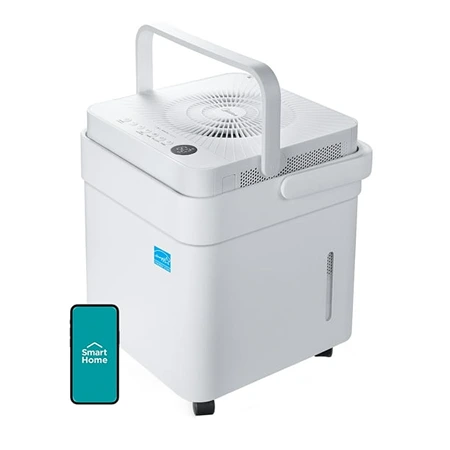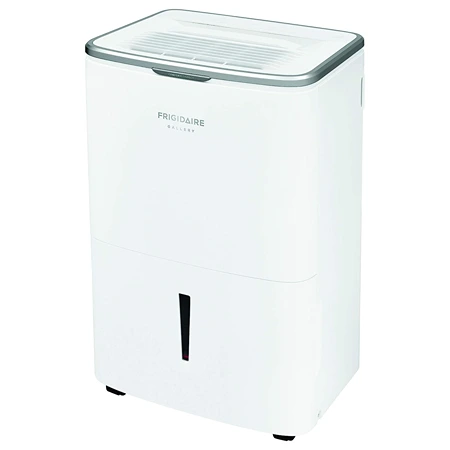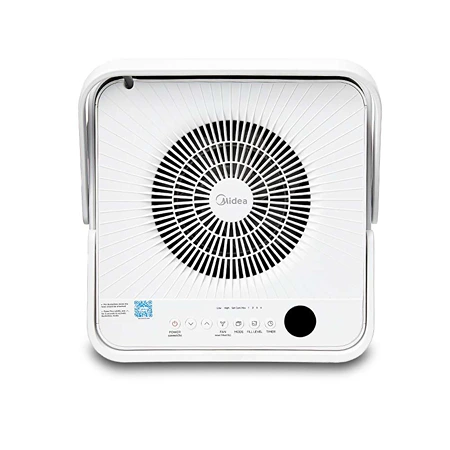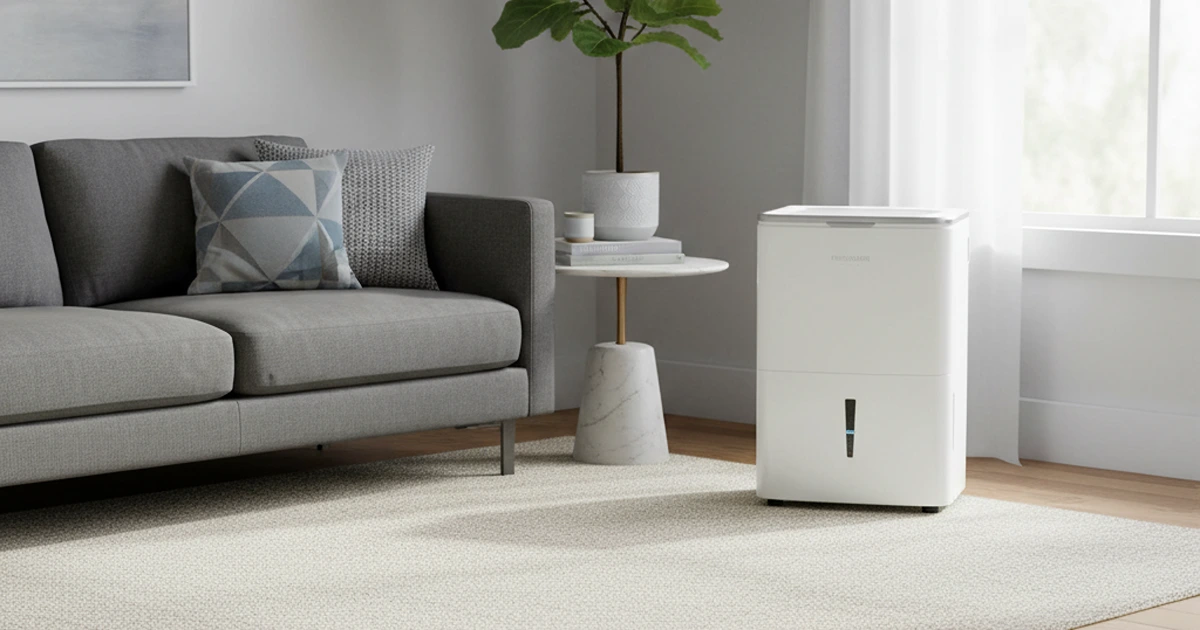If the air in your home has ever felt musty, muggy, or just plain damp, you’re not alone. Many people describe their indoor air as dank, wet, or even mildewy, and in these cases, a good dehumidifier can bring real relief. By pulling excess moisture out of the air, dehumidifiers can make your home feel fresher and more comfortable while also helping to prevent mold, mildew, and other moisture-related problems.
That said, dehumidifiers aren’t a perfect solution. While they do measurably reduce humidity, the category has a long track record of mechanical failures, with units across many brands breaking down sooner than expected. We’re cautiously optimistic about newer models like the Midea Cube, which has shown promise with its innovative design, but reliability is still something to keep in mind. For those who want peace of mind, we also cover durable, repairable commercial-grade options.
Ultimately, the best approach is a combination: investing in a solid dehumidifier while also tackling the root causes of excess moisture in your space. With the right setup, you’ll improve your home’s air quality, extend the lifespan of your unit, and finally say goodbye to that dreaded “moist” feeling in the air.

Midea 50 Pint Cube
Best Overall Option
The Midea 50 Pint Cube offers powerful moisture removal in a compact, stackable design with easy water disposal and smart features.
Buy on AmazonThe Midea 50 Pint Cube is a standout option among modern dehumidifiers, offering powerful performance in an innovative design. Unlike traditional single-unit models, the Cube is composed of two parts: a condenser unit that sits atop a large bucket during operation and nests inside it for storage. This structure allows the Cube to hold more than twice the water capacity of most 50-pint dehumidifiers, collecting up to 4.25 gallons before needing to be emptied. The expanded capacity adds convenience by reducing the frequency of trips to dump water, although it can also make the unit heavier to manage when full.
Reliability is another area where the Midea 50 Pint Cube distinguishes itself. While dehumidifiers as a category often receive concerning numbers of complaints about premature breakdowns, reports of failures with the Cube are notably less frequent. Owners generally find the Cube to be durable and dependable, which is an important factor for a device that may be running continuously in challenging conditions.
Performance is strong across the board. The Cube reduces humidity levels as effectively as its peers, cutting relative humidity by more than 10 percent within an hour whether on high or low settings. With a 50-pint daily removal capacity, it is well suited for large spaces up to about 1,200 square feet, making it an effective solution for basements, living areas, or any part of the home prone to dampness.
Energy efficiency is also a key advantage. The Cube carries an Energy Star Most Efficient rating and uses R-32 refrigerant, which has a lower global warming potential than the commonly used R-410A. Even at high output, it consumes a reasonable 460 watts, making it one of the more efficient ways to keep humidity under control in larger areas.
Noise levels are impressively low. At 51 decibels measured from six feet away with the compressor running, it is quieter than most competing models. When the compressor cycles off, the fan produces a subtle white noise similar to that of a household fan or air vent, which blends easily into the background.
That said, the Cube is not without drawbacks. Its biggest convenience, bucket size, also presents the greatest challenge. To empty a full reservoir, users must first lift the 38-pound condenser unit off, then move the bucket itself, which can weigh close to 40 pounds when filled with water. The included casters are small and provide little help on rough basement flooring. These limitations make it less practical for those unable to manage the weight, though the Cube can be set to shut off before reaching full capacity or drained continuously using the supplied hose.
Connectivity features also leave room for improvement. The Wi-Fi-enabled app can be unreliable, with common complaints about difficulty syncing to smartphones or using the Alexa integration. When functioning properly, the app displays humidity levels, allows remote control of fan speeds and timers, and sends alerts when the bucket is full. Unfortunately, inconsistent connectivity and limited support from customer service can diminish the usefulness of these features.
The Midea 50 Pint Cube combines quiet operation, impressive capacity, and dependable reliability in a way few other models do. Its weight and occasional app frustrations may be drawbacks, but for larger spaces where frequent emptying is inconvenient, it stands out as one of the most innovative and capable dehumidifiers you can buy.

Frigidaire Gallery FGAC5045W1
Best Upgrade Option
The Frigidaire Gallery FGAC5045W1 offers strong moisture removal, Wi-Fi connectivity, and a lighter, easier-to-handle bucket design.
Buy on AmazonThe Frigidaire Gallery FGAC5045W1 stands out as one of the best smart-enabled dehumidifiers available, offering reliable connectivity and strong performance. Its Wi-Fi integration is more stable and easier to set up than many competitors, and the app provides accurate alerts when the bucket is full. For those who value remote control, the model also works with Amazon Alexa and Google Assistant, making it one of the most user-friendly smart dehumidifiers on the market.
When it comes to raw performance, the FGAC5045W1 is a strong contender. In controlled conditions, it reduced humidity by over 12 percent on high and 15 percent on low within an hour. With a daily moisture removal capacity of 50 pints, it is capable of keeping large spaces dry, whether you are dealing with a damp basement, humid living room, or moisture-prone storage area.
The design makes day-to-day use fairly convenient. A tuck-away handle and cord hanger simplify moving it in and out of storage. The hose attachment for passive draining is straightforward and less awkward than on some competing models, making it easier to set up continuous drainage into a sink or floor drain. It also operates more quietly than some earlier Frigidaire models, producing a consistent hum that blends into the background rather than intruding on daily life.
That said, there are some trade-offs. The bucket has a smaller capacity of 2.1 gallons compared to the Midea Cube’s 4.25 gallons. This means the bucket will need to be emptied about twice as often if you are not using continuous drainage. For smaller households this may not be a major concern, but in spaces with high humidity, the frequent emptying could become inconvenient.
Subscribe to Product Bible
Stay updated with the latest product reviews, buying guides, and expert recommendations. Fresh advice on the best things we've researched, tested, and reviewed, sent to your inbox weekly.
Want to know more about how we handle your data or opt out of marketing emails? Check out our Privacy Policy. If you have any questions, we're always here to help.
Longevity is another area where the FGAC5045W1 raises questions. Owner reports suggest a higher incidence of mechanical failures with Frigidaire units compared to models from Midea. While this model has not been singled out for problems beyond what is typical in the category, it is something to weigh if reliability is a top priority.
The FGAC5045W1 also includes an ionizing air purification feature, but this function is best left off. Ionizers are of questionable benefit and can generate trace amounts of ozone. More useful is the washable prefilter that captures larger particles like dust and pet hair. Frigidaire also sells upgraded RAC-1 and RAC-2 filters, which can help reduce smaller airborne particles such as pollen and mold spores, though they are not true HEPA filters. These optional add-ons can make the machine more versatile for users who want to combine humidity control with light air cleaning.
Despite these drawbacks, the Frigidaire Gallery FGAC5045W1 is an excellent choice for those who value smart controls, dependable app functionality, and straightforward day-to-day use. While it may require more frequent emptying and has a less consistent track record for long-term durability than some competitors, it offers strong moisture removal, useful connectivity, and a thoughtful design that makes it one of the best upgrade options in the dehumidifier market.

Midea 20 Pint Cube
Best Budget Option
The Midea 20 Pint Cube offers reliable humidity control in a compact, stackable design at an affordable price point.
Buy on AmazonThe Midea 20 Pint Cube is a scaled-down version of the larger 50 Pint Cube, offering the same innovative design in a smaller, lighter, and more affordable package. It retains the two-piece structure of a condenser unit paired with a bucket, which allows it to nest for compact storage and sit stacked during use. With its reduced size, it is best suited for smaller basements, laundry rooms, or problem areas up to about 500 square feet.
Performance is consistent with the strengths of its bigger sibling. The 20 Pint Cube effectively maintains target humidity levels and can handle typical moisture issues in moderately sized spaces. Its daily capacity makes it practical for rooms that experience dampness without requiring the power of a full 50-pint model. The smaller footprint also makes it easier to move and store, which adds to its appeal for those looking for a more compact solution.
Like the larger Cube, this model is most convenient when paired with passive drainage into a sink, floor drain, or sump. Manual emptying requires lifting the condenser unit off the bucket before carrying the full reservoir, which can be cumbersome. A filled bucket on the 20 Pint Cube weighs around 28 pounds, and the condenser itself adds another 30 pounds when positioned on top. For that reason, continuous drainage is the best way to take full advantage of the Cube’s design without the strain of frequent heavy lifting.
The Midea 20 Pint Cube is a solid choice for those who want the innovative design and reliability of the Cube lineup at a lower cost and in a more manageable size. While it shares some of the same drawbacks as the larger model, its performance, energy efficiency, and compact design make it one of the best budget-friendly dehumidifiers available for smaller spaces.
A good dehumidifier can make a dramatic difference in the comfort and health of your living space. By keeping indoor humidity in check, these machines help prevent mold, mildew, and musty odors while also protecting furniture, electronics, and structural elements from moisture damage. Choosing the right model depends less on bells and whistles and more on finding a balance between capacity, convenience, and reliability for your particular space.
It is also important to remember that no dehumidifier is a cure-all on its own. Addressing the root causes of excess moisture, such as leaks, poor ventilation, or inadequate drainage, will ensure the machine works more effectively and lasts longer. When paired with these measures, a quality dehumidifier is not just an appliance but an investment in cleaner air, a healthier home, and peace of mind.
